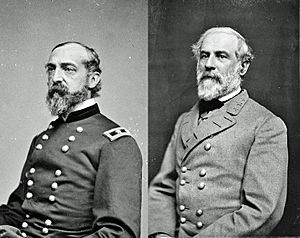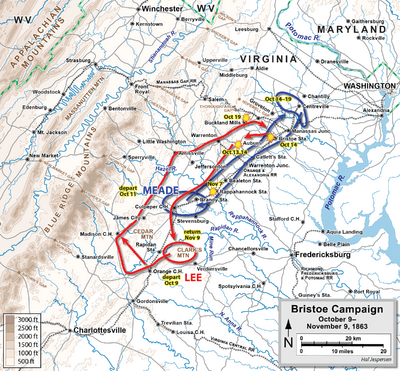Bristoe Campaign facts for kids
Quick facts for kids Bristoe Campaign |
|||||||
|---|---|---|---|---|---|---|---|
| Part of the American Civil War | |||||||
 George G. Meade and Robert E. Lee, commanding generals of the Bristoe Campaign |
|||||||
|
|||||||
| Belligerents | |||||||
| Commanders and leaders | |||||||
| Units involved | |||||||
| Army of the Potomac | Army of Northern Virginia | ||||||
| Strength | |||||||
| 76,000 | 45,000 | ||||||
| Casualties and losses | |||||||
| 4,815 | |||||||
The Bristoe Campaign was a series of small battles. They happened in Virginia during the American Civil War. This was in October and November 1863. General George G. Meade led the Union's Army of the Potomac. He tried to defeat Robert E. Lee's Army of Northern Virginia. But his plan didn't work out.
Lee tried a clever move instead. He wanted to get around Meade's army. Meade didn't want to fight where Lee chose. So, he slowly pulled his army back. They moved towards Centreville. His goal was to stop Lee. He didn't want Lee to get between his army and Washington, D.C..
Contents
What Happened Before the Campaign?
In September 1863, General Lee had to send some of his soldiers away. His I Corps, led by General James Longstreet, went to Chattanooga, Tennessee. General Meade also lost some of his troops. His XI and XII Corps were sent to Tennessee too.
After these changes, Lee had about 55,000 soldiers. Meade's army still had about 80,000 men. Meade was not happy about losing his soldiers. He felt he didn't have enough troops to beat Lee. But Lee still planned to try and get around Meade's army. He wanted to cut off Meade from Washington, D.C.
Lee's Secret Move
On October 9, the Confederate soldiers started moving early in the morning. They tried to move without being seen. They avoided hills and dusty roads. This was so their marching wouldn't create dust clouds. Dust clouds could be seen for miles.
Lee knew that if Meade found out, he would either fight or move north. But Union guards noticed something strange. There were no drum or bugle calls from the Confederate camps. Also, there was no smoke from their morning cooking fires.
Word was sent to Meade's headquarters. The Confederate army seemed to be moving west. Meade didn't know exactly what was happening. But he was worried. Lee might be moving south to Richmond. Or he could be trying to get around Meade's army to the north. Meade also knew that President Lincoln was unhappy. Lincoln thought Meade let Lee escape after the Battle of Gettysburg. So, Meade knew he had to act.
Finding Lee's Army
All day on October 9, Meade waited for news about Lee's movements. That evening, he sent orders to General John Buford. Buford's 1st Cavalry Division was to cross the Rapidan River. Their job was to find out where the Confederates were.
But Buford didn't get the orders until the next morning. His cavalry left right away. However, they didn't reach the old Confederate camps until 11:00 a.m. It wasn't until sunset that they found Confederate troops. This happened at Morton's Ford. Meade didn't get this news until the next day, October 11.
At Culpeper Courthouse, Meade started to think Lee was moving north. He thought Lee was trying to get around his army. But he still had no clear reports. By the night of October 10, Meade decided it was too risky to fight in the small area of Culpeper. He thought it might give Lee an advantage. So, he ordered his entire army to move north of the Rappahannock River.
Buford had not heard that the Union army was moving north. He waited for help from the I Corps on the morning of October 11. Instead, Confederate cavalry attacked him. The Union and Confederate cavalry fought all day. By evening, Buford had fought his way back across the Rappahannock. But this fight kept the Union cavalry from finding Lee's main army.
Key Battles of the Campaign
First Battle of Auburn (October 13)
On October 13, Confederate General J.E.B. Stuart's cavalry was riding ahead of Lee's army. They accidentally ran into Union soldiers. These Union troops were guarding a supply train. Stuart saw that his men were outnumbered. So, his cavalry hid in thick bushes. They waited for a chance to attack.
But they soon found themselves surrounded by Union troops. The Union soldiers didn't even know Stuart's men were there. The Confederate cavalry stayed hidden. They gathered information about what they saw.
Second Battle of Auburn (October 14)
The next morning, Stuart's cavalry fought their way out of the area. This fight was called the Second Battle of Auburn.
Battle of Bristoe Station (October 14)
On October 14, 1863, General Hill's Confederate Corps attacked two Union corps. The Union soldiers were retreating north. Hill made a big mistake. He didn't send out scouts to see what they were up against.
One of Hill's divisions was badly beaten. They also lost an artillery battery (a group of cannons). Hill brought in more soldiers to strengthen his line. But he couldn't make any progress. The Union corps were dug in behind a railroad embankment. After beating Hill, the Union army continued to Centerville, Virginia. Lee was very angry with Hill for his mistakes at Bristoe Station. He told Hill, "bury your dead and say no more about it!"
Buckland Races (October 19)
After the defeat at Bristoe Station, Lee's army started to pull back. Stuart's cavalry helped protect their retreat. Union cavalry, led by General Judson Kilpatrick, chased Stuart's men. They followed them along the Warrenton Turnpike.
But Kilpatrick's men were led into a trap near Chestnut Hill. They were completely defeated. The Union soldiers were scattered and chased for five miles. This event became known as the "Buckland Races."
Crossing the Rappahannock (November 7)
Lee returned to his old position behind the Rappahannock River. But he left a strong bridgehead on the north bank. This protected the way to Kelly's Ford. On November 7, Meade forced his army across the Rappahannock at two places.
General John Sedgwick's VI Corps launched a surprise attack at dusk. They overran the Confederate bridgehead at Rappahannock Station. They captured two Confederate brigades. This was more than 1,600 men from General Jubal A. Early's division. The fighting at Kelly's Ford was not as fierce. But the Confederates retreated. This allowed the Union soldiers to cross in large numbers.


